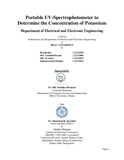| dc.contributor.advisor | Rhaman, Dr. Md. Khalilur | |
| dc.contributor.author | Kabir, Ifran | |
| dc.contributor.author | Hossain, Md. Taushik | |
| dc.contributor.author | Al-Amin, Md. | |
| dc.contributor.author | Shupta, Jahanara Akter | |
| dc.date.accessioned | 2017-08-21T07:15:39Z | |
| dc.date.available | 2017-08-21T07:15:39Z | |
| dc.date.copyright | 2017 | |
| dc.date.issued | 2017-04-18 | |
| dc.identifier.other | ID 12121018 | |
| dc.identifier.other | ID 12121006 | |
| dc.identifier.other | ID 12121015 | |
| dc.identifier.other | ID 12121014 | |
| dc.identifier.uri | http://hdl.handle.net/10361/8417 | |
| dc.description | This thesis report is submitted in partial fulfillment of the requirements for the degree of Bachelor of Science in Electrical and Electronic Engineering, 2017. | en_US |
| dc.description | Cataloged from PDF version of thesis. | |
| dc.description | Includes bibliographical references (page 48). | |
| dc.description.abstract | Bangladesh is mainly depended on agriculture for her economy. Agriculture is the backbone of Bangladesh. Thousands of people depend on agriculture. About 60-70% people depends on agriculture. Agriculture is the main source of our countries economy. It comprises about 15% of the country's GDP and 60% of the total labor force.It is revealed that paddy is the mostly produced crop in this area and fertilizers and pesticides were intensively used for boosting up the production of crops. Fertilizer consumption (% of fertilizer production) in Bangladesh was 314.42 as of 2013. Its highest value over the past 11 years was 440.66 in 2011, while its lowest value was 121.21 in 2002. The problem is that humans tend to use too much of fertilizers in the soil because they have to cater to the global demand of food. To mention more than half of the total yield production is out of synthetic or inorganic fertilizers which contains components like nitrogen, potassium, sulfur, calcium, magnesium, and so on. These chemicals and minerals, although help in boosting the growth of plants, they also have their drastic side effects in the long run. Farmers of Bangladesh use either greater amount or less amount of fertilizer than the standard amount provided by government. Most of the farmers and agrochemical dealers were not aware about the impact of fertilizer and pesticide on crop production and environment as well. This outcome draws base line situation which can be useful towards relevant research. Thus we develop a portable device by which concentration ofPotassium (K) in soil can be detected. Farmers will be able to judge what amount of fertilizers to be used for that particular soil thus excessive use of fertilizers can be drastically reduced. | en_US |
| dc.description.statementofresponsibility | Ifran Kabir | |
| dc.description.statementofresponsibility | Md. Taushik Hossain | |
| dc.description.statementofresponsibility | Md. Al-Amin | |
| dc.description.statementofresponsibility | Jahanara Akter Shupta | |
| dc.format.extent | 50 pages | |
| dc.language.iso | en | en_US |
| dc.publisher | BRAC Univeristy | en_US |
| dc.rights | BRAC University thesis is protected by copyright. They may be viewed from this source for any purpose, but reproduction or distribution in any format is prohibited without written permission. | |
| dc.subject | Photometry | en_US |
| dc.subject | Fertilizer | en_US |
| dc.subject | Potassium | en_US |
| dc.title | Portable UV-spectrophotometer to determine the concentration of potassium | en_US |
| dc.type | Thesis | en_US |
| dc.contributor.department | Department of Electrical and Electronic Engineering, BRAC University | |
| dc.description.degree | B. Electrical and Electronic Engineering | |

